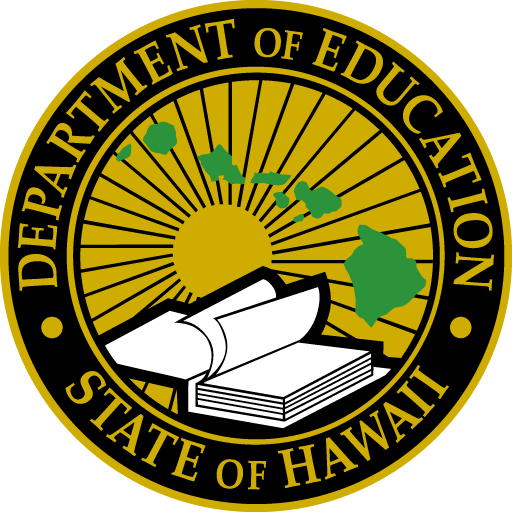Testing measures student progress during their academic journey. Mandatory assessments are given to students at select grade levels in elementary, middle and high school. There are also targeted exams for Kaiapuni, English Learners, and students with cognitive disabilities.
Smarter Balanced Assessment (SBA)
The Smarter Balanced Assessments (SBA) in mathematics and English language arts/literacy (ELA) are aligned to the Hawaiʻi Common Core Standards and designed to measure whether students are “on track” for readiness in college and/or career. These are mandatory assessments given to students in Grades 3-8 and 11.
Hawaiʻi Smarter Balanced Portal
The Hawaiʻi Smarter Balanced Portal is a resource to help you prepare for the Hawaiʻi Smarter Balanced Assessments that includes student training, practice tests, important dates and tools for students, families and teachers.
About SBA
Students in Grades 3–8 and 11 take the SBA in the spring. Families receive results in the fall prior to the public release of school- and state-level results.
Results:
- 2025 results: English Language Arts/Mathematics (EXCEL) | HSA-Science (EXCEL)
- 2024 results: English Language Arts/Mathematics (EXCEL) | HSA-Science (EXCEL)
- 2023 results: English Language Arts/Mathematics (EXCEL) | HSA-Science (EXCEL)
- 2022 results: English Language Arts/Mathematics (EXCEL) | Science (EXCEL)
For students, SBA offers:
- More complex problems and challenges them to support their answers with explanations and evidence.
- The ability to mark test items for review, take notes on a digital notepad, use calculators and other tools in certain sections, and also pause the test.
- The opportunity to be placed in credit-bearing courses at a number of colleges and universities, including the University of Hawaiʻi system of colleges. See Chart Your Path to College with Smarter Balance (PDF) for more information.

Teachers administer formative assessments—small, frequent academic checks—throughout the year. This is supported with Tools for Teachers (formerly known as Digital Library) to which our teachers contribute items. Teachers are able to print reports and discuss students’ real-time performance and progress with parents.
For the Smarter Balanced summative assessments conducted in the spring, teachers have access to student scores within two weeks, allowing them to adjust instruction in the final weeks of the school year. Reports will also be provided to educators who will be teaching students the following school year to help inform their instruction.
Parents or legal guardians—including those with disabilities or those who are not proficient in English—may request an alternate format of the report, such as Braille, large print, or an oral translation, by contacting the school or the Assessment Section.
SPECIAL NEEDS: Students with significant cognitive disabilities take the HSA-Alternate exams in ELA/literacy, mathematics and science.
OTHER ACCOMMODATIONS: Test accommodations are any adjustments made to tests or testing conditions that allow students with physical or learning disabilities to demonstrate their true achievement level on standardized exams or other high-stakes tests. Common adjustments include:
- American Sign Language
- Braille or large print text
- having someone else write down test answers
- listening to reading passages read aloud by text-to-speech (TTS) software
HAWAIIAN LANGUAGE: For students in Kaiapuni Hawaiian language immersion schools, the Department and its partners at the University of Hawaiʻi-Mānoa developed the Kaiapuni Assessment of Educational Outcomes (KĀ‘EO) assessments for Grades 3 and 4 in the Hawaiian language. The assessments are aligned to the standards and measure progress toward preparing students for success in college, career and community. The Department has a “double testing” waiver from the U.S. Department of Education in place so Kaiapuni students in those grades do not also have to take the SBA.
Summative Assessment Components
Students taking the SBA summative assessment do the following:
- A computer adaptive test: An online adaptive test that provides an individualized assessment for each student.
- A performance task: Tasks that challenge students to apply their knowledge and skills to respond to real-world problems. They can best be described as collections of questions and activities that are coherently connected to a single theme or scenario. They will be used to better measure capacities such as depth of understanding, research skills, and complex analysis, which cannot be adequately assessed with selected- or constructed-response items. Some performance task items can be scored by the computer; most will be manually scored.
They are not timed; students will be given appropriate time to answer all questions. SBA can also be administered over several days.
ONLINE PRACTICE TESTS: Students, teachers and parents nationwide have access to sets of assessment questions aligned to the Common Core that can be used for professional development and discussions with policymakers and other interested stakeholders. The practice tests are available at our AlohaHSAP portal. These are only a preview and do not encompass the full range of content that students may encounter. Also, they are presented in a “fixed form” (i.e., not computer adaptive) and users will not receive reports or scores.
2025-26 Administration
| Content Areas | Grade(s) or Track(s) | Testing Window | ||
| Open | Close | |||
| ELA/Literacy & Mathematics | 3-8 and 11 | 02/17/26 | 05/28/26 | |
| 1st semester students at block schedule schools ONLY | 11 | 11/17/25 | 12/19/25 | |
| Multitrack | 3-8 Yellow | 02/17/26 | 05/28/26 | |
| 3-8 Red, Blue, Green | 03/09/26* | 06/12/26* | ||
*Subject to change.
Kaiapuni Assessment of Education Outcomes (KĀ‘EO)
The purpose of the KĀʻEO is to support a fair, valid and reliable assessment that demonstrates:
- The achievement of Hawaiian language immersion schools in Hawaiian language arts, mathematics and science for the purpose of community accountability as well as state and federal accountability.
- An appropriate pathway to grow and improve the Hawaiian language immersion program in classroom curriculum, at the school level, in Hawaiian immersion families, and in the broader community.
- The reliability and validity of building the foundation of an assessment that is informed by Hawaiian knowledge, wisdom and intelligence.
About the Development of KĀʻEO
He oia mau nō ka pono o ka lāhui kanaka i ka naʻauao Hawaiʻi.
Language is the marker of identity and has a vision of the past, present and future; “Language not only transmits visions of the past but also expressions of social relationships, individual friendships as well as community knowledge, a wealth of organizing experiences, rules about social relationships plus ideas about art, craft, science, poetry, song, life, death and language itself.” (Baker, 2011, p.45)
Learning what Skutnabb-Kangas (2009) terms a mother-tongue language, such as the Hawaiian language, is an act of reconnecting with ancestors, understanding one’s current place in the world as indigenous peoples, and imagining the future of our language, culture and community through a Hawaiian language lens. These benefits and rights have been confirmed by the United Nations Declaration on the Rights of Indigenous Peoples (2008).
Hawaiian immersion students had previously been included in the statewide assessment program which was built on a worldview and language derived from a majority perspective. A central tenet of the KĀʻEO is to develop a more valid measure for assessing immersion students by placing culture and language at the center of the assessment program. Thus, throughout the assessment development, the program focused on building an assessment that would be more relevant and accessible to support the inclusion of immersion students. This was accomplished because all the assessment development tasks – framework development, item writing, item review, scoring, and standard setting – encompassed a purposeful collaboration and involvement of teachers from across the islands. These educators contributed a vast amount of knowledge about their communities, variations in academic language, and educational philosophy resulting in a community of ownership in the process and product, in turn garnering community support.
Students enrolled in Hawaiian language immersion programs approach the standards in Hawaiian language medium and are assessed using the KĀ‘EO.
To fulfill the requirements of the Hawaiʻi State Constitution, the Hawaiʻi State Board of Education adopted Policy 105-8 states: The Kaiapuni Educational Program offers students an education in the medium of the Hawaiian Language. The comprehensive program combines the use of Hawaiian teaching methodologies, language, history, culture and values to prepare students for college, career and to be community contributors within a multicultural society.
This policy further states that HIDOE develop curriculum and standards to prepare students for college, career and community contribution.
KĀʻEO Statewide Reporting
Public and public charter school students in the Hawaiian language immersion program are administered the language arts and mathematics assessments in Grades 3-8 and the science assessments in Grades 5 and 8.
| Content Area | Grade(s) | TESTING WINDOW | |
| Open | Close | ||
| Language Arts & Mathematics | 3-8 | 04/01/26* | 05/28/26 |
| Science | 5 and 8 | 04/01/26* | 05/28/26 |
* Subject to change.
Technical reports
The Standards for Educational and Psychological Testing (AERA, APA, NCME, 2014) identifies professional standards, criteria and recommendations for test developers and test publishers. One of those standards is to provide sufficient documentation that enables potential test users to evaluate the quality of a test, including evidence for the reliability and validity of test scores. Technical reports provide that documentation.
Smarter Balanced
Smarter Balanced Assessments – Hawaiʻi
- 2023-24 Hawaiʻi SB Technical Report (PDF)
- 2022-23 Hawaiʻi SB Technical Report (PDF)
- 2021–22 Hawaiʻi SB Technical Report (PDF)
- 2020–21 Hawaiʻi SB Technical Report (Google Drive)
- 2018–19 Hawaiʻi SB Technical Report (Google Drive)
- 2017–18 Hawaiʻi SB Technical Report (Google Drive)
Hawaiʻi Assessments in Science
(Grades 5 and 8 and Biology 1 End of Course Exam)
- 2023-24 NGSS and Biology EOC Technical Report (Google Drive)
- 2022-23 NGSS and Biology EOC Technical Report (Google Drive)
- 2021–22 NGSS and Biology EOC Technical Report (Google Drive)
- 2020–21 HSA Science-Biology Technical Report (Google Drive)
- 2018–19 HSA Science-Biology Technical Report (Google Drive)
End-of-Course (EOC) Exams (Algebra 1 and Algebra 2)
Hawaiʻi Statewide Alternate Assessment (HSA-Alt)
- 2023-24 HSA-Alt Technical Report (PDF)
- 2022–23 HSA-Alt Technical Report (PDF)
- 2021–22 HSA-Alt Technical Report (PDF)
- 2020–21 HSA-Alt Technical Report (Google Drive)
Kaiapuni Assessment of Educational Outcomes (KĀʻEO)
- 2024 KĀʻEO Technical Report (Google Drive)
- 2023 KĀʻEO Technical Report (PDF)
- 2022 KĀʻEO Technical Report (PDF)
- 2021 KĀʻEO Technical Report (PDF)
- 2019 KĀʻEO Technical Report (PDF)
- 2018 KĀʻEO Technical Report (Google Drive)
- 2018 KĀʻEO Field Test Technical Report (Google Drive)
Hawaiʻi English Language Proficiency Assessment
(WIDA ACCESS and Alternate ACCESS)
Please contact the Assessment Section to request an electronic copy of a technical report not listed above. Please specify the assessment name and year.
